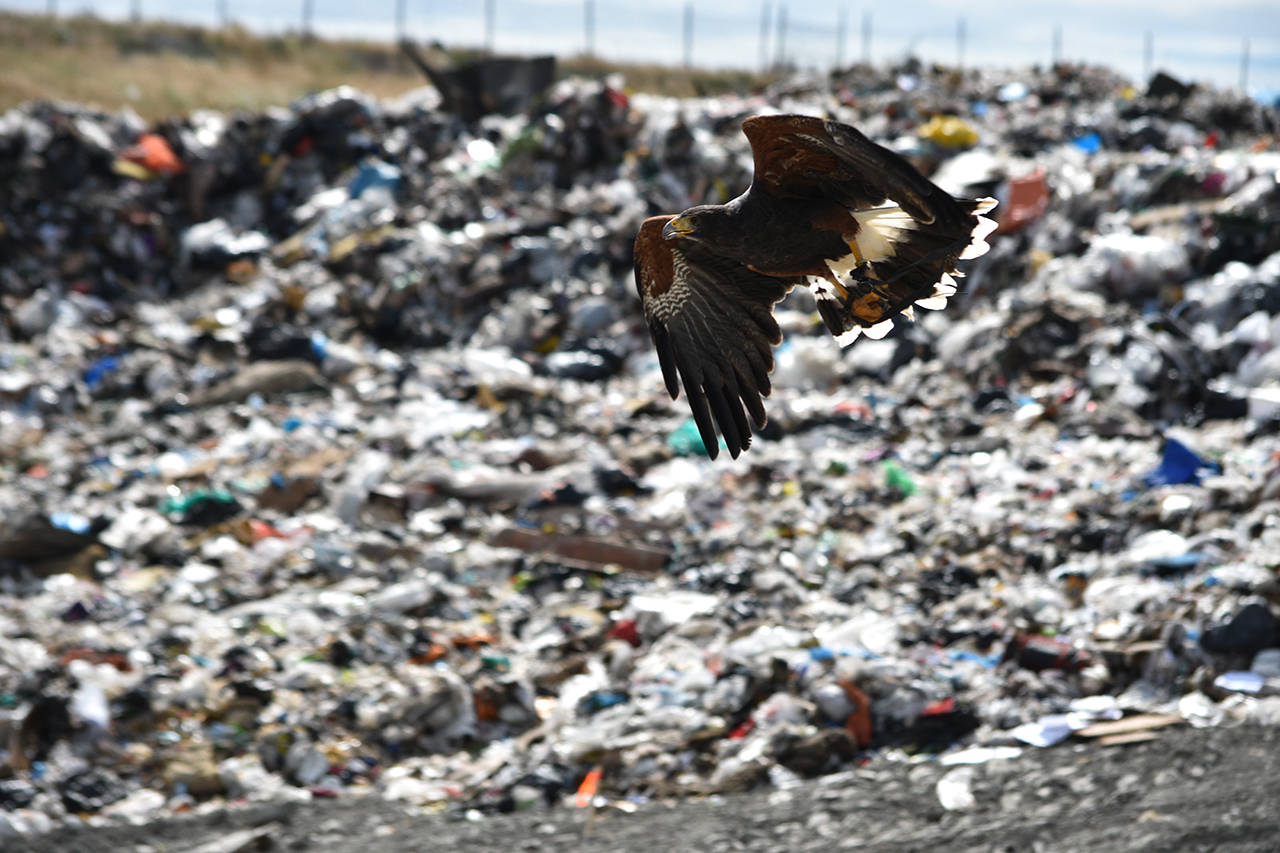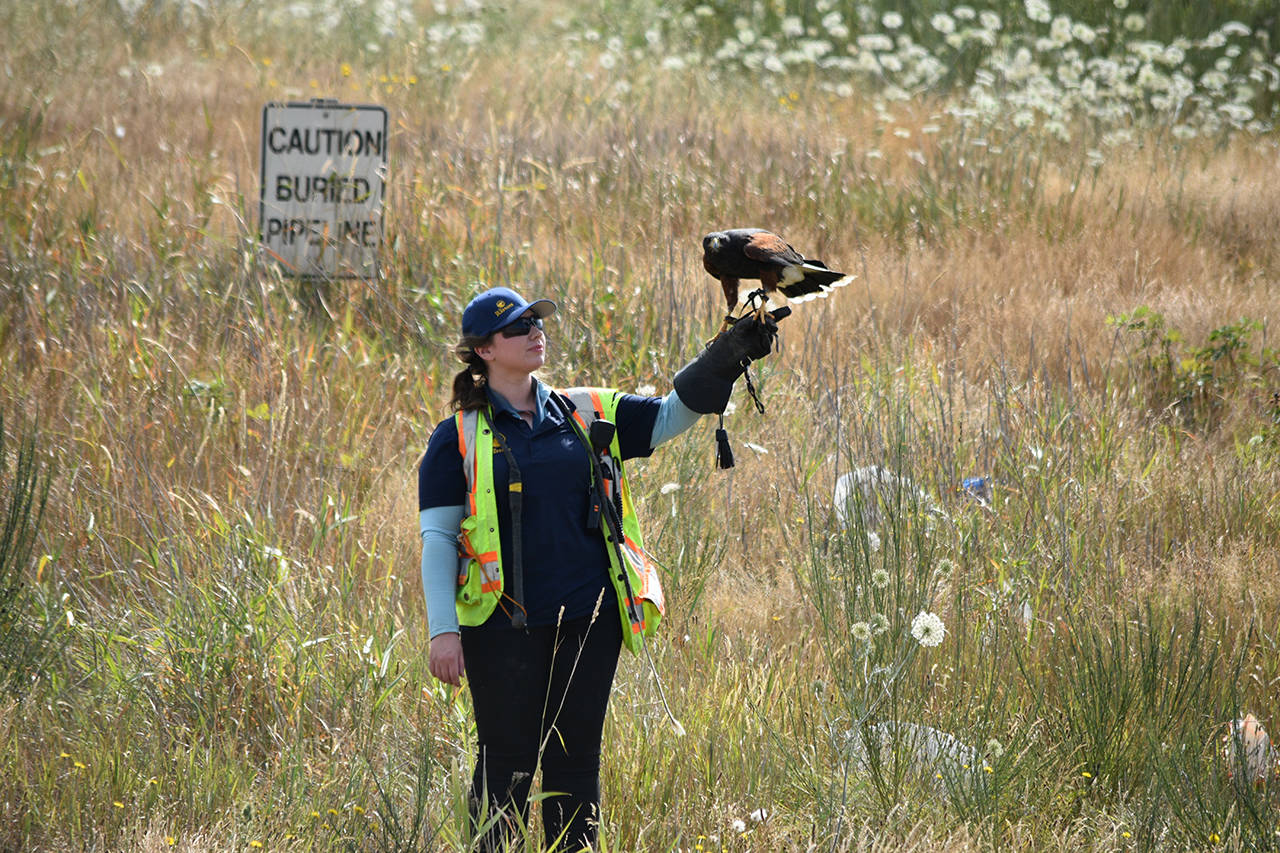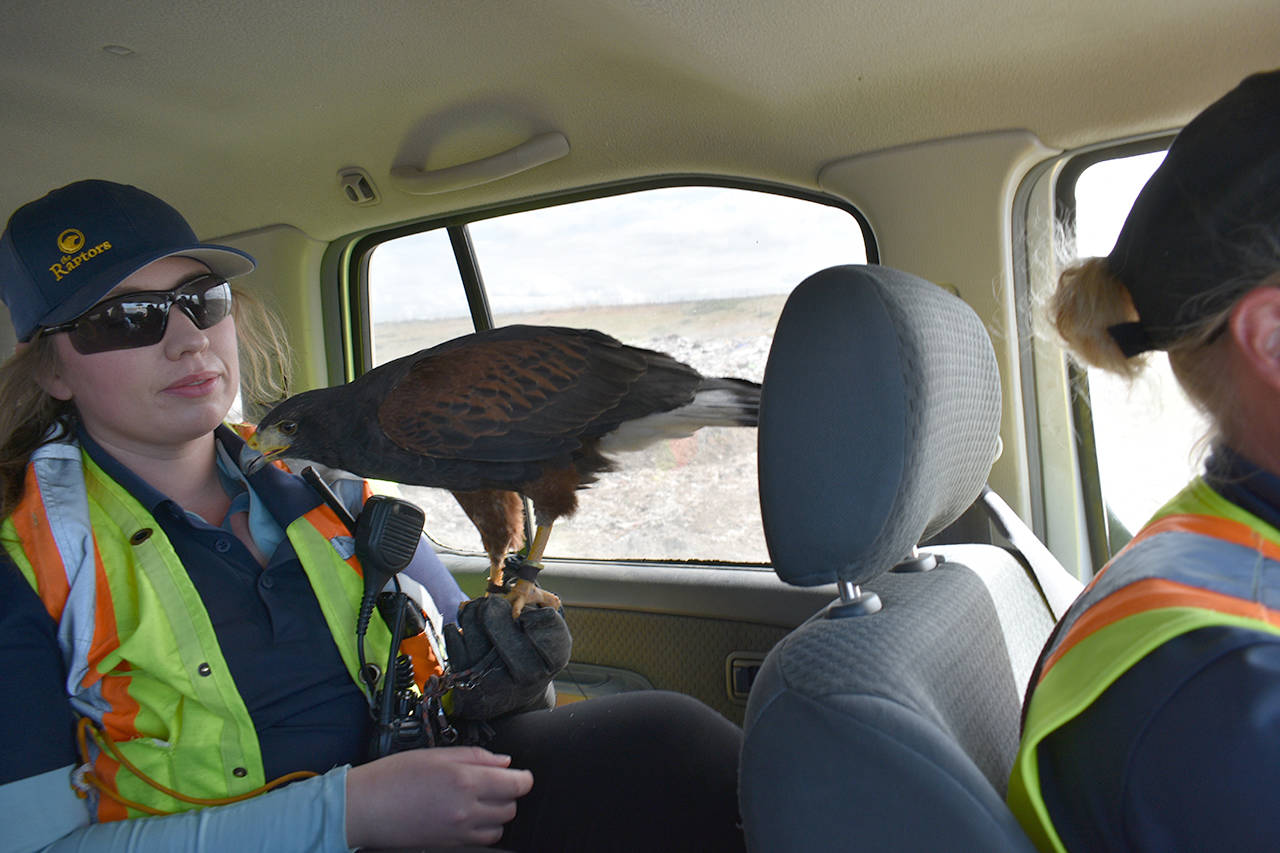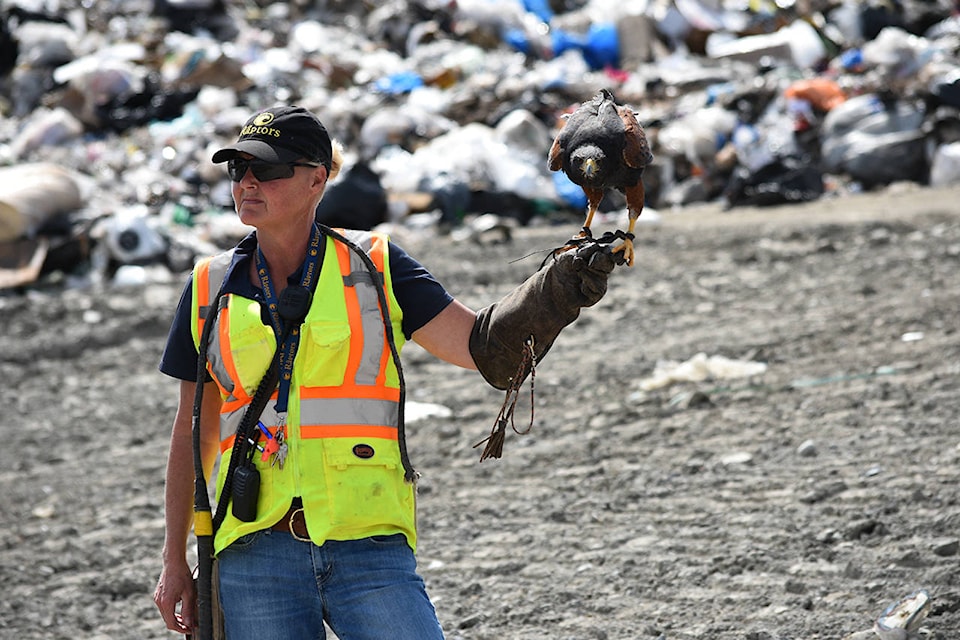It was a sunny summer Friday when Jessica Baynton drove her silver Nissan Xterra down the dusty roads of the Vancouver Landfill.
She wasn’t making a run to the dump. In fact, the most landfill-worthy item in the car — a Furby tied to the roof — had been rescued from the trash heap sometime before.
Rather, Baynton and her companion Goose, the Harris’s hawk perched in the back seat of the vehicle, were there for a different reason.
She pulled off the main road and parked the car next to a lake fronted by five beige buildings and a container office. The harsh calls of hawks echoed from the buildings and were lost into the wind that was pushing across the water.
“These are our bird aviaries,” she said, leaving Goose to preen his feathers in the car. “They get kind of a lake view.”
| The aviaries at the Vancouver Landfill. (Grace Kennedy photo) |
Goose and the four other hawks that live beside the lake at the Vancouver Landfill are owned by The Raptors, a company created by enthusiast Gillian Radcliffe to provide education and wildlife management services using trained birds of prey.
Since 2015, the company has provided bird control services to the landfill, helping keep local gull populations away from the garbage.
Baynton, although she knows the landfill well, isn’t there full time. She manages all of The Raptors’ Vancouver-area projects, which this summer number between 10 and 20. The real “rock stars of the landfill,” as Baynton called them, were sitting inside the office.
Mindy Dick, 51, and Miriam Ennis, 29, work full-time at the landfill. In the summer, they are the only two bird control team members around. In the winter, they are part of a larger team of part-time staff that keep glaucous-winged and ring-billed gulls away from the garbage seven days a week.
“We’re actually keeping them safe by keeping them off the garbage,” Dick said, sitting in the office she had decorated with eagle-patterned curtains and raptor paintings. “There’s a lot of heavy machinery up there, and [we’re] preventing them from being run over or squished.”
There are, of course, many reasons why the landfill would hire a bird control team to manage the gulls that come from miles around to feast on its garbage. One is to prevent the transportation of waste by gulls that pick it up and fly away. Another, as Dick mentioned, is to maintain the health of the gulls that are tempted by the easy pickings. Worker health and safety is also key.
| Gulls flying over the active face of the Vancouver Landfill. (Grace Kennedy photo) |
“When you get swarms of gulls, it’s not great for worker health and safety,” Baynton explained. “Some of them get dizzy with the swarms of gulls.”
“When there’s thousands and thousands, [the workers] get disoriented,” Dick added.
She isn’t sure how many gulls swarmed the landfill before it hired a bird control team, but in some places, the birds can fill an area to the point where it’s “just a wall of white movement.”
But it hasn’t been like that at the Vancouver Landfill. “Not since we’ve been here,” she said, then laughed.
Dick and Ennis have been at the landfill since the bird control team started there three years ago. Dick had been a long-time employee at The Raptors, although she took a five year leave to work at the Orphaned Wildlife Rehabilitation Society.
“I wanted to learn everything there was to know, inside and out, about these birds,” Dick said. “And then this opportunity came up at the landfill and I was in like a dirty shirt.”
Ennis came on board via a different route; she was a marine biologist in Nova Scotia when she started working in emergency animal medicine.
“I was able to work a lot more with birds and wildlife, and I fell in love with them,” she said. “It’s so different from working in marine biology, because the birds have such strong personalities. And the interactions with them every day are just awesome.”
The birds, key partners in the team at the landfill, are what keep Dick and Ennis coming in to work every day.
“You just sort of have blinders on to the fact that you’re traipsing through garbage all day,” Dick said. “When you get to hang out with these birds, I couldn’t do anything else. Ever.”
| Leia, a Harris's Hawk, outside the main building for the Vancouver Landfill's bird control team. (Grace Kennedy photo) |
| Georgia, one of Raptor's red tailed hawks. She's on vacation for the summer as she undergoes a significant molt. (Grace Kennedy photo) |
Each day at the landfill starts with the birds. Ennis and Dick weigh each of the five birds in the morning, to ensure they are the right weight for optimal flying. Then, one or two birds will hop in the Xterra with Ennis and Dick, and the team will make their way to the open garbage face.
On the Friday Baynton was there, the team took out one bird: Leia, a Harris’s hawk that is one of the best chasers in the team.
Georgia, a red-tailed hawk, came out for a visit but didn’t join them at the open face. Ordinarily the “star hawk” on site, she was on summer vacation after spending most of the season losing and regrowing her feathers.
“When she’s out hunting, the gulls really pay attention,” Dick said, holding Georgia in the entrance of her aviary.
“Actually, Jess [Baynton] and I, we were working together one day — it was years ago when that was an active face,” Dick said, looking over to the large hill near the entrance of the landfill — “and she came, she was flying around. And she went in for the chase and she cleared the entire site.
“There wasn’t a gull left,” Dick said.
But on the Friday, there weren’t many gulls to chase away.
Some picked their way through the garbage, hopping up into the air when a truck drove too close, only to settle back down onto the garbage again. Some flew away when the Xterra parked next to the face; the rest vanished when Dick cracked the bull whip she had brought with her from the office.
“We have such an association with the gulls now, because it’s usually the same gulls returning every day,” Baynton said. “Sometimes our vehicle will drive up and all of a sudden all of them are leaving.”
“They get to know our lunch breaks,” Dick added. “They are very smart. So we always have to keep them guessing.”
That guessing comes, in part, from the whip Dick had slung around her neck. The team uses a mixture of pyrotechnics, bull whips and live hawks to harry the gulls. On some days, Dick and Ennis will release the hawks and let them chase the gulls around like a predator catching prey — that is most effective in the winter, when the gulls are starved and persistent.
| Mindy Dick is the resident whip artist on site. She uses bull whips to clear away gulls and other birds from the landfill. (Grace Kennedy photo) |
On other days, the pair will let the bird fly between them, or let it follow them along like a dog on a walk. Standing next to the open face, Dick and Ennis called for Leia to fly between them. She decided instead to land on the grassy hill a couple of metres away.
Then, something flew overhead.
“Oh, eagle!” Dick shouted, cracking her whip as the juvenile bald eagle swooped above the spot where Leia had landed.
“Sometimes we do have to watch for wild bird interactions,” Baynton explained. “It’s one of the reasons we fly mostly hawks here, because the hawks and the eagles tend to get along a little bit better than the falcons.”
Dick lit off a pyrotechnic, and the eagle flew off.
Eagles are a common sight at the landfill, and taking care of them also falls to the bird control team. Some (Kickstand, Grandpa, One-eyed Willie) are regular visitors, returning year after year. Others come by only once in a while. In the winter, there can be as many as 3,000 eagles at the site.
“It’s like a really weird ecosystem,” Baynton said.
“In the winter, you will have a bald eagle on every single one of those posts up there,” she said, looking at the fence on top of the hill. “And you’ll get thousands of gulls.”
It’s an ecosystem that never allows for a dull moment, where it’s not only the birds that change, but the landscape itself.
As more garbage enters the landfill, the open face fills up and changes. Roads that once held open access are closed off, and hills build up where flat land used to be.
“The landfill environment is always changing, because they are always building it,” Baynton said.
Dick agreed. “It’s a constant adapt, adapt, adapt.”
grace.kennedy@northdeltareporter.com
Like us on Facebook and follow us on Twitter



